Durrani
The Durrānī (Pashto: دراني, pronounced [durɑˈni]1) formerly known as Abdālī (ابدالي), are one of the largest tribes of Pashtuns. Their traditional homeland is in southern Afghanistan (Loy Kandahar region), straddling into Toba Achakzai in Balochistan, Pakistan, but they are also settled in other parts of Afghanistan and parts of Khyber Pakhtunkhwa, Pakistan. Ahmad Shah Durrani, who is considered the founder of the modern state of Afghanistan, belonged to the Abdali tribe. In 1747, after establishing the Afghan Empire based in Kandahar, he adopted the epithet Shāh Durr-i-Durrān, "King, Pearl of Pearls," and changed the name of the tribe to "Durrani" after himself.[1][2]
دراني | |
|---|---|
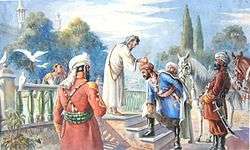 | |
| Regions with significant populations | |
| Afghanistan, Pakistan | |
| Languages | |
| Pashto | |
| Religion | |
| |
Most Durranis speak southern Pashto, which is considered a prestigious variety of Pashto.[3]
Descent and origin
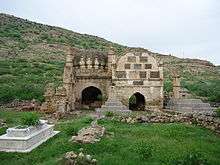
In the early modern period, the Abdali tribe of Pashtuns was first explicitly mentioned in Mughal and Safavid sources. For example, in the 1595 Mughal account Ain-i-Akbari, the Abdali were mentioned as one of the "Afghan ulūs" (Pashtun tribal confederacies) settled in Kandahar area, along with Tarīn, Paṇī, and Kākaṛ. Some scholars have postulated that the Abdali descended from Hephthalite tribes, who settled in present-day Afghanistan in ancient times and were known as ηβοδαλο (Ebodalo) in Bactrian language.[4]
According to linguist Georg Morgenstierne, the tribal name Abdālī may have "something to do with" the Hephthalite.[5] This hypothesis was endorsed by historian Aydogdy Kurbanov, who indicated that after the collapse of the Hephthalite confederacy, they likely assimilated into different local populations and that the Abdali may be one of the tribes of Hephthalite origin.[6] 19th-century British Indian explorers, Charles Masson and Henry W. Bellew, also suggested that there was a direct relationship between Abdalis and Hephthalites.[7][8]
Joseph T. Arlinghaus referred to a Syriac chronicle from c. 555 CE, which mentions Khulas, Abdel, and Ephthalite as three of the nomadic tribes from the "lands of the Huns." Arlinghaus linked the "Khulas" and the "Abdel" to the Khalaj (modern Ghilji) and the Abdali (modern Durrani), respectively, arguing that the relationship between the Hephthalite, the Khalaj, and the Abdali may date back as far as the sixth century.[9]
Yu. V. Gankovsky, a Soviet historian on Afghanistan, also asserted that the Hephthalite contributed to the ethnogenesis of Durrani Pashtuns:[10]
The Pashtuns began as a union of largely East Iranian tribes, which became the initial ethnic stratum of the Pashtun ethnogenesis, dating from the middle of the first millennium CE, and is connected with the dissolution of the Hephthalite confederacy... Of the contribution of the Hephthalites to the ethnogenesis of the Pashtuns, we find evidence in the ethnonym of the largest of the Pashtun tribe unions, the Abdali (Durrani after 1747), associated with the ethnic name of the Hephthalites — Abdal. The Siah-posh, the Kafirs (Nuristanis) of the Hindu Kush, called all Pashtuns by a general name of Abdal still at the beginning of the 19th century.
Mythical genealogy
According to a popular mythical genealogy, recorded by 17th-century Mughal courtier Nimat Allah al-Harawi in his book Tārīkh-i Khān Jahānī wa Makhzan-i Afghānī, the Abdali tribe descended from their eponymous ancestor Abdāl (or Awdāl), who was son of Tarīn, who was son of Sharkhbūn, who was son of Saṛban (progenitor of the Sarbani tribal confederacy), who was son of Qais Abdur Rashid (progenitor of all Pashtuns). Qais Abdur Rashid was a descendant of Afghana, who was described as a grandson of the Israelite king Saul and commander-in-chief of the army of prophet Solomon. Qais was claimed to be a contemporary of the Islamic prophet Muhammad and a kinsman of Arab commander Khalid ibn al-Walid. When Khalid ibn al-Walid summoned Qais from Ghor to Medina, Qais accepted Islam and the prophet renamed him Abdur Rashīd (meaning "Servant of the Guide to the Right Path" or "Servant of God" in Arabic). Abdur Rashid returned to Ghor and introduced Islam there. The book stated that Abdur Rashid's great-grandson, Tarīn, had three sons: "One was black in complexion, and he was named Tōr (meaning "black" in Pashto); the other was white in complexion, and he was named Spīn (meaning "white" in Pashto); his third son was named Abdāl (or Awdāl)." The first two sons were the progenitors of modern Tareens, who are closely related to Durranis and are divided into two clans (Tor Tareen and Spin Tareen), while the third son was the progenitor of modern Durranis.[11]
The 1595 Mughal account Ain-i-Akbari also mentioned the tradition of Israelite descent among Pashtuns, which shows that the tradition was already popular among 16th-century Pashtuns.[4]
History
During the 16th and 17th centuries, the Abdali were primarily pastoralists, not known for agricultural activities, but some of them were engaged in overland trade. Abdali and Tarin (a Pashtun tribe related to Abdalis) chieftains were patronized by both Safavid and Mughal appointed governors, and asked to patrol travel routes to ensure the safety of merchant caravans passing through Kandahar, which was a province located on a strategic trade corridor linking Hindustan, Iran, and Turkestan.
Hotak dynasty
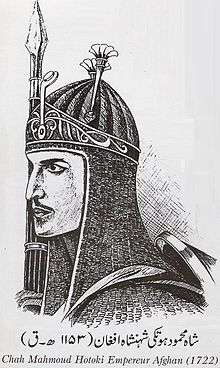
The first Ghilji Emir of the Hotak dynasty, Mirwais Hotak (1709–1715), was married to Khanzada Sadozai, daughter of Abdali chief Jafar Khan Sadozai. This cemented a Ghilji-Abdali alliance that played an integral role in Mirwais' rise to political authority in Kandahar and in the successful revolt against the Safavids.[4] A product of the marriage, Mahmud Hotak, conquered Iran in 1722, and the Iranian city of Isfahan remained the dynasty's capital for six years.
During the Hotak rule, an Abdali contingent went to Herat to assume control of the province, replacing the former Safavid appointed governors. Zaman Khan Abdali, father of Ahmad Shah Durrani, was one of the Abdali governors of Herat.
Durrani Empire
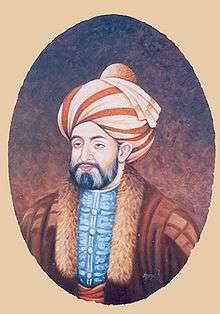
In 1747, Ahmad Shah Durrani established the Durrani Empire with its capital at Kandahar. He adopted the title Shāh Durr-i-Durrān, "King, Pearl of Pearls," and changed the name of his tribe "Abdali" to "Durrani" after himself.
Ahmad Shah is now regarded as the founder of the modern state of Afghanistan. Within a few years, he extended his control from Khorasan in the west to Kashmir and North India in the east, and from the Amu Darya in the north to the Arabian Sea in the south.[12]
Barakzai dynasty
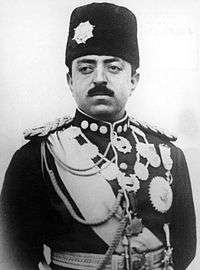
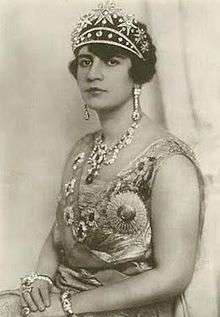
In 1823, Emir Dost Mohammad Khan, who belonged to the Barakzai tribe of Durranis, founded the Barakzai dynasty centered at Kabul.[13] Thereafter, his descendants ruled in direct succession until 1929 when King Amanullah Khan, under whom Afghanistan gained independence over its foreign policy from the British Raj, was forced to abdicate and his cousin Mohammed Nadir Shah was later elected king. The Barakzai dynasty ruled present-day Afghanistan until 1973 when Mohammed Zahir Shah, the last Barakzai king, was overthrown in a bloodless coup by his cousin Mohammed Daoud Khan. The coup ended the Barakzai kingdom and established the Republic of Afghanistan (1973–1978).[14]
Contemporary period
.jpg)
Contemporarily, the former Afghan president Hamid Karzai (2001–2014) is the leader of the Popalzai clan of Durranis.[15]
Pashto dialect
Although many are bilingual in Dari Persian, the Durrani of southern Afghanistan speak Southern Pashto, also known as "Kandahari Pashto", the "soft" dialect of Pashto. It is considered one of the most prestigious varieties of Pashto. This dialect retains archaic retroflex sibilants [ʂ] and [ʐ], which have merged into other phonemes in other dialects.[3] Southern Pashto also preserves the affricates [t͡s] and [d͡z], which have merged into [s] and [z] in some dialects.
The Tareen (Tarin) tribe is historically closely related to Durranis. Although most Tareens speak Southern Pashto, a small section of the Spin clan of Tareens living east of Quetta speaks the unique Wanetsi (Tareeno) dialect of Pashto, which is considered by some linguists to be distinctive enough to be classified as its own language. According to linguist Prods Oktor Skjaervo: "The Pashto area split into two dialect groups at a pre-literary period, represented today on the one hand by all the dialects of modern Pashto and on the other by Wanetsi and by archaic remains in other southeast dialects."[16]
Subtribes
Notes
- ^1 In Pashto, "Durrani" (دراني, [durɑˈni]) is the plural form of the word. Its masculine singular is "Durranai" (درانی, [durɑˈnay]), while its feminine singular is "Durraney" (درانۍ, [durɑˈnəy]).
References
- The Hephthalites: Archaeological and Historical Analysis, Aydogdu Kurbanov, Berlin, 2010, page 242.
- Runion, Meredith L. (2017-04-24). The History of Afghanistan, 2nd Edition. ABC-CLIO. ISBN 9781610697781.
- Coyle, Dennis Walter (August 2014). "Placing Wardak among Pashto varieties" (PDF). University of North Dakota:UND. Retrieved 26 December 2014.
- The Pearl of Pearls: The Abdālī-Durrānī Confederacy and Its Transformation under Aḥmad Shāh, Durr-i Durrān by Sajjad Nejatie. https://tspace.library.utoronto.ca/handle/1807/80750.
- Morgenstierne, Georg. "The Linguistic Stratification of Afghanistan." Afghan Studies 2 (1979): 23–33.
- Kurbanov, Aydogdy. "The Hephthalites: Archaeological and Historical Analysis." PhD dissertation, Free University of Berlin, 2010.
- Masson, Charles. Narrative of Various Journeys in Balochistan, Afghanistan, the Panjab, & Kalat, during a Residence in those Countries: To which is Added an Account of the Insurrection at Kalat, and a Memoir on Eastern Balochistan. 4 vols. London, 1844. Reprint, New York: Oxford University Press, 1974–77.
- Bellew, Henry Walter. An Inquiry into the Ethnography of Afghanistan. Woking, 1891. Reprint, Karachi: Indus, 1977.
- Arlinghaus, Joseph T. "The Transformation of Afghan Tribal Society: Tribal Expansion, Mughal Imperialism and the Roshaniyya Insurrection." PhD dissertation, Duke University, 1988.
- Gankovsky, Yu. V. (1982). A History of Afghanistan. Progress Publishers. p. 382.
- Tareen or Tarin. 10 April 2015. Khyber.ORG.
- Chayes, Sarah (2006). The Punishment of Virtue: Inside Afghanistan After the Taliban. Univ. of Queensland Press. p. 99. ISBN 978-1-932705-54-6. Retrieved 23 September 2010.
- Tarzi, Amin H. "DŌSTMOḤAMMAD KHAN". Encyclopædia Iranica (Online ed.). United States: Columbia University.
- Rubin, Barnett. "DĀWŪD KHAN". In Ehsan Yarshater (ed.). Encyclopædia Iranica. Retrieved 8 June 2020.
- Taliban run-in highlights dangers for Afghan opposition leader Archived 25 August 2013 at the Wayback Machine. 6 November 2001.
- Hallberg, Daniel G. 1992. Pashto, Waneci, Ormuri. Sociolinguistic Survey of Northern Pakistan, 4. LINK